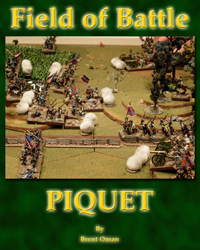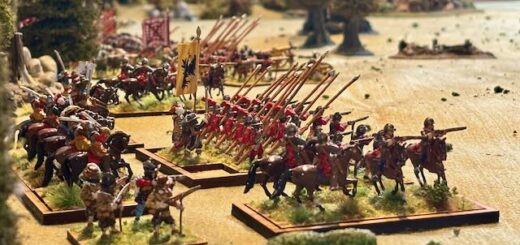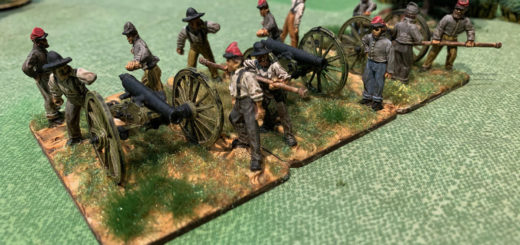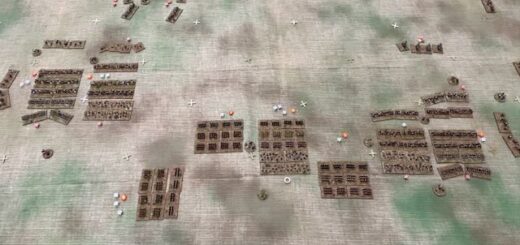Field of Battle
Regolamento della serie Piquet.

Field Of Battle Charts and Cards.pdf
FIELD OF BATTLE, SECOND EDITION
AUTHOR: Brent Oman
RELEASE DATE: July 2011 (anticipated)
Changes introduced by the Second Edition include:
MOVEMENT
- Leadership Die Rolls: Now only WINNING even LD rolls allow âfancy Businessâ, but all units may initiate melee on a winning Even LD roll, not just attack columns.
- March Column: Units that BEGIN THE GAME (or enter the table as reinforcements) in March Formation may deploy at any time using a MOVE segment for the change; thereafter normal deployment rules apply. (I originated this and have been using it for years – necessary, especially for any scenarios where there are reinforcements marching onto the table!)
- Limbered Artillery: Similarly, artillery units that BEGIN the game (or enter the table as reinforcements) may unlimber at any time using a MOVE segment for the change; thereafter normal deployment rules apply.
- Skirmishers: ignore terrain penalties for Class II and II Terrain on an winning EVEN LD roll.
- Players with multiple command groups must choose which group to roll for first, then move that group. Then chose the next, and roll for an move that group, Then the next, and so forth. You may not roll for all your groups and then decide who to move and in what order!
- Leaders: Army Commanders may now ONLY move on a LEADERSHIP card, and only a single (16â)segment. Command group leaders move with their commands, and as many segments as their command rolls, as well as up to 16â on each LEADERSHIP card.
- Rout Movement: is now 8â + D6 for infantry and 12â + D6 for Cavalry (less variable than previously)
- New rules/clarifications are added for moving into and out of town sections, and across rivers, fords and bridges. (I think these are very helpful)
UNIT RATINGS
The variability/overlap between ratings has been reduced somewhat â in other words, it is more likely that RAW and RABBLE units (D4 defense die types) will have CD’s of 8, and less likely for them to have higher CD’s than prior, and conversely fewer if any CRACK and ELITE units will have CD od 8, and more will have CD of D12+1 than in FoB1. Cavalry have moved up about a die type for CD on average, and Heavy Artillery have moved up somewhat on average, too.
LEADERSHIP RATINGS
are unchanged, however a semantic change in Sequence deck quality is introduced, now ranging from Abysmal to Poor to Average to Skilled to Excellent (instead of Superior to Excellent). Sequence deck compositions are unchanged.
FIRING:
No significant changes.
MELEE:
- Procedure: Melees now only end when at least one side suffers 1 UI loss; if this doesn’t happen in a given roll, any effects (Out of Command for units that roll Odd) are imposed immediately, but units remain in contact, hits are *CARRIED OVER*, and another round fought immediately. This continues until at least one side suffers 3 hits or more total(1 UI or more), at which point the melee is over and the loser retreats a distance equal to the total hits suffered in all rounds fought. (this should make Melee more decisive)
- Modifiers: a) The UP 1 for Initiating melee applies only on the first round if initiating melee on an Even LD die roll, but for all rounds when initiating on the MELEE card. b) The unit with a higher Defense Die Type gets an UP 1. c) Units that are Outnumbered (engaged by 2 enemy units) get a DOWN 1 modifier, plus there is a new procedure for resolving 2:1 melees.
-
Results: Units that suffer 2 or more UI in a single round will ROUT; units that lose 2UI or more in a single round vs. Cavalry that rolled EVEN are destroyed.
-
Pursuit: Victorious cavalry and Natives that roll Odd in their final round lose 1 UI as pursuers; no actual pursuit move is made, and the UI may be regained. There is no Morale point cost for this Pursuit UI loss; however, if this reduces the victorious unit to zero UI it is removed from the game (rather than routing). (I like this change, as I tend to dislike Pursuit rules in general)
-
Routed units that are contacted by the enemy are destroyed outright, but no additional Morale Points are lost for this.
-
New rules are added for Cavalry evading from melee against infantry and artillery, and Limbered Artillery and Skirmishers evading from melee. In all cases this occurs AFTER the first round of melee (if they survive without Routing).
- Squares in Melee: have a new procedure, but the cavalry vs infantry in square modifier is eliminated (I personally question if this was intentional or an oversight!).Squares may only be engaged in melee on a Melee card, not on an Even winning LD roll.
RALLYING: the procedure is unchanged, but modifiers have changed slightly; the test is now DOWN 2 for Routers at zero UI, but only Down 1 for Routers with 1 or more UI remaining. The TACTICAL ADVANTAGE Card also may now be used to modify the roll.
ARMY MORALE CARD:
- New rules (harsher penalties) are imposed for armies whose C-in-C has been lost and not yet replaced.
- New Army Morale test results â now, if your C-in-C fails the roll, game over; your army retires from the field! If your C-in-C has been lost, the army automatically fails the roll. (I like this change; for large Multiplayer games Morale Points may be tracked and the Moral test taken on a Corps by Corps basis)
MELEE! CARD: This card now allows units within HALF a move segment of the enemy to move into contact with the enemy and resolve melee immediately. There are restrictions: Target must be in line of sight, move must be straight without change of facing (incline move is allowed), and no interpenetration of friendly units is allowed. Additionally, the ½ move to contact may NOT be used across rivers (and presumably streams), fords, or bridges. (I absolutely adore this change; we tested it in two games at Historicon 2010, and I liked it so much I’ve played with this rule ever since. It speeds up the game, and now the appearance of the MELEE card is often a big deal, as opposed to fairly ho-hum previously).
TACTICAL ADVANTAGE CARD: May now be used to modify any ONE roll other than an Army Morale check/ (Question: does this include the LD vs LD roll for Initiative?; one would think not but it appears to be allowed by the above). (I like this change, too – it puts a bit more usefulness in this otherwise fairly bland card).
POINTS SYSTEM: a decidedly optional points system is included in FoB2. Points range from a low of 34.4 for a Rabble Light Artillery battery to 127 for an Elite Heavy Cavalry unit; a standard Regular Infantry unit is 60.6. (Myself I’d probably divide these by 5, rounding up/down for a little easier math (to me at least) â that would make the Rabble Light Artillery 7 points, the Regular infantry 12, and the Guard Heavy Cavalry 25. Actually, I probably wouldn’t use it at all, but still it can be useful to have for those who like them, and when trying to assess a scenario for balance.)
RANDOM SCENARIO GENERATION: FoB2 includes a system for this; I have no further information about this, but would note that Brent has already done scenario generation in great depth for Theater of War and also Command Piquet previously; I would expect the system to be similar to those, but I could be completely wrong there!



